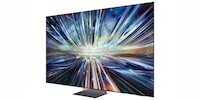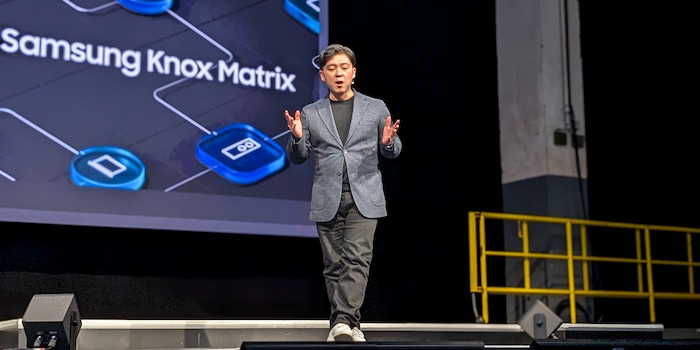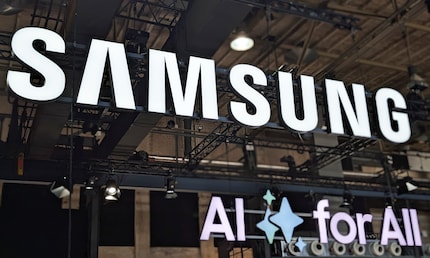
Background information
Eclipsa Audio: Samsung and Google’s descent on Dolby Atmos
by Luca Fontana

Samsung is number one in the TV market – but the competition is catching up. While China is attacking with competitive prices, Samsung is focusing on AI, 8K and micro-LED. But is that enough? A conversation about market strategies, Dolby Vision and the future of television.
Alongside journalists from all over Europe, I was invited to Fredenhagen near Frankfurt am Main, where Samsung presented its entire product portfolio for the coming year at the World of Samsung event. My focus was on the TV business, of course. And I’d brought along some questions: how does Samsung intend to stay at the top? Where’s the market for 8K televisions? And why does Samsung continue to ignore Dolby Vision?
I spoke to Jose Barreiro-Lopez, Samsung’s European Head of TV and Sound, and Charlie Chulho Bae, Head of TV and Sound Product Management in Europe. We covered all my questions and more. We spoke about strategies, technological visions and why Samsung is convinced that Micro-LED is more than just a dream of the future.

Samsung dominates the TV market like no other. But TCL and Hisense are increasingly pushing forward with competitive prices. LG and Sony have already overtaken them. Are you still untouchable – or do you feel the pressure?
Jose Barreiro-Lopez: we’ve been the market leader in TVs for 19 years and in soundbars for 11 years, that’s a fact. But our focus has long gone beyond traditional televisions. It’s why we’ve integrated Vision AI into both our TVs as well as projectors and lifestyle products. We launched the lifestyle TV category – with appliances such as The Frame, The Serif and The Terrace – back in 2016 with Vitra and the Kolek brothers. Our goal’s clear: we want to continue to grow and tap into new segments, including those outside the mainstream.
And what about classic televisions? They’re still the heart of your business.
Jose: This is precisely why we’re constantly investing in innovation. Samsung has a loyal customer base that appreciates our diversity – from televisions and smartphones to household appliances and even medical technology. Many manufacturers would be happy to have such a broad base. But for us, it’s about more than individual devices – we think in terms of ecosystems. Over 285 million people use SmartThings, our platform that connects everything from entertainment to home technology.
«Tizen OS, our smart TV system, will now receive updates for seven years – this is virtually unprecedented in the TV industry.»
However, a huge ecosystem alone isn’t enough to remain number one in the long run. What sets Samsung apart from the competition?
Jose: One crucial point is our openness to partnerships. SmartThings doesn’t just work with Samsung devices, it also integrates brands such as Philips Hue, Ring and even car manufacturers. We deliberately rely on an open platform. What’s more, Tizen OS, our smart TV system, will now receive updates for seven years – this is virtually unprecedented in the TV industry.
Sometimes, however, it seems as if televisions are getting more and more features. Many remain unused. Do you really want to pack even more functions into your TVs?
Jose: That’s right, technology shouldn’t be overwhelming, it should make life easier. A TV doesn’t have to be a Swiss Army knife where most people are only using half the tools. Instead, a television should adapt. If you want to switch directly from a movie to a game, there’s no need to wade through menus – the TV recognises the console and switches automatically. Just sit down and get started.
«Dolby Vision? We don’t adopt existing standards – we prefer to develop our own technologies that improve the viewing and listening experience.»
Dolby Vision remains a hot topic: many tell me they’d buy a Samsung TV immediately – if Dolby Vision were on board. Why do you still only stick with HDR10+? Why are you accepting this market loss?
Charlie Chulho Bae: For us, the decisive factor isn’t whether HDR10+ or Dolby Vision is «better». But we believe in HDR10+ – which is why we’re developing it further in a targeted manner. And we’re open to partnerships: we’ve implemented Eclipsa 3D Audio with Google, for example. Still, instead of adopting existing standards, we concentrate on creating new features that noticeably improve the viewing experience.
Regardless, this sounds like a clear no to Dolby Vision to many.
Jose: Yes, I understand that. But for us, the topic is broader. We’re focusing heavily on AI optimisation for visuals and sound – this is where the greatest potential lies in taking an experience to the next level. Technologies such as Q-Symphony, where the TV and soundbar work in harmony, make a real difference for us.
Does that mean Samsung doesn’t see any added value in Dolby Vision?
Jose: We do, but our priorities lie elsewhere. We develop technologies that pay off across our entire product range – not just in the TV sector. For example, take the areas of safety and sustainability: we rely on recycled materials, solar cells in remote controls and wireless power supplies. It’s the big picture that counts for us.
Let’s change topics. Last week, I spoke to Shoji Ohama, Sony’s «European TV boss». In his view, there’s no content and no demand for 8K. As a result, Sony has withdrawn from the 8K business in recent years. You, on the other hand, continue to invest in it. Why?
Charlie: Oh, 8K content very much exists! On YouTube, for instance, and you can film in 8K with a Galaxy smartphone. At the same time, we’re investing heavily in AI upscaling, which visibly improves low-resolution content. One thing’s for sure: without an 8K panel, you can’t see real 8K – even if the source material is available. It’s why we’re continuing to drive the technology forward – now also with Vision AI.
But how do you respond to criticism that says real 8K content is still limited?
Jose: There’ll be more – especially user-generated content, for example in Central and Eastern Europe. Many film in 8K, upload it, and share it. It was no different with HDR or HD-ready. Even back then, the infrastructure only developed over time. We believe that the trend will be similar for 8K.
«8K isn’t just technology for today – it’s about being prepared for the content that will come.»
So, in your opinion, the problem isn’t a lack of content as Sony said, but the adoption of displays?
Jose: Exactly. It’s why we also implement our AI upscaling in 4K models. This means that even users without an 8K TV can benefit from the better picture quality. Whether it’s for old family videos or photos, our AI makes images sharper. For us, 8K isn’t a snapshot, but an investment in the future.
And what about Micro-LED? For almost ten years, it’s been hailed as the miracle technology for a future that’s «coming soon» – but so far, it’s only been an expensive luxury for stadiums or cinemas. Let’s be honest: Micro-LED will never become a reality for home TV use.
Jose: On the contrary. Micro-LED has long been part of our portfolio – you saw the technology for yourself at IFA or CES. Last year, for example, we showed off our transparent Micro-LED there, then RGB Micro-LED at CES this year. We also offer Micro-LEDs for the home.
«Micro-LED is already a product for end customers – just mainly for those looking to splash out on the crème de la crème.»
Agreed, but Micro-LED is and remains a premium product with a price that makes it unaffordable for most people – that’s my point. A 76-inch model, for example, costs over 80,000 francs, roughly the same as a new Tesla.
Jose: Sure, that’s a different price level. But Micro-LED is on sale – for example at Harrods or Selfridges in London or at premium retailers in Switzerland. For people who really only want the best. The crème de la crème, if you will. This has always been the case with new technologies.
And when will this finally change for Micro-LED?
Jose: That’s hard to say. We’re working on reducing costs – but the technology is extremely complex. It requires expensive materials, precise manufacturing and special processes. Nevertheless, Micro-LED isn’t a dream of the future. It’s real, available to end customers – and we’re continuing to drive development forward with transparent variants and other new approaches.
Charlie: Think back to OLED: when we first introduced the technology in 2013, it was almost unaffordable. Today, it’s standard. I think Micro-LED will go the same way. The technology is improving, production is becoming cheaper – and little by little, it’s coming within reach.
«The way we experience TV is about to change – and we’re actively driving this change.»
One last question: let’s jump to the year 2035. I enter my living room – what can I expect? A massive screen, a holographic display or nothing at all since the TV is completely integrated into its surroundings?
Jose: The next big shift is sure to come. What exactly will it look like? That’s still a secret. But one thing’s clear: the way we experience television is changing fundamentally. It’s why we at Samsung no longer just talk about TVs, but Vision AI as a holistic idea. First came lifestyle TVs, then projectors, interactive displays like The Premiere 5 – now we’re already thinking about holographic interfaces.
Sounds exciting. So will there be no more classic televisions? Only projections and holographic displays?
Jose: The market will decide that. Some still want a large screen on their wall, others opt for mobile or flexible solutions. We’ll continue to develop both. Where is it heading? We’ll see – literally.
Charlie, if you had to bet: what will dominate our living rooms in ten years’ time – OLED, micro-LED or something completely new?
Charlie: Probably a combination of many things. There won’t be one technology to replace all others. But one thing’s certain: whether quantum dots, AI-supported image processing or micro LEDs, we want to be at the forefront. Our aim is to build technology in such a way that it fits seamlessly into everyday life.
Perfect. Thank you for the interview!
I write about technology as if it were cinema, and about films as if they were real life. Between bits and blockbusters, I’m after stories that move people, not just generate clicks. And yes – sometimes I listen to film scores louder than I probably should.
Interesting facts about products, behind-the-scenes looks at manufacturers and deep-dives on interesting people.
Show all